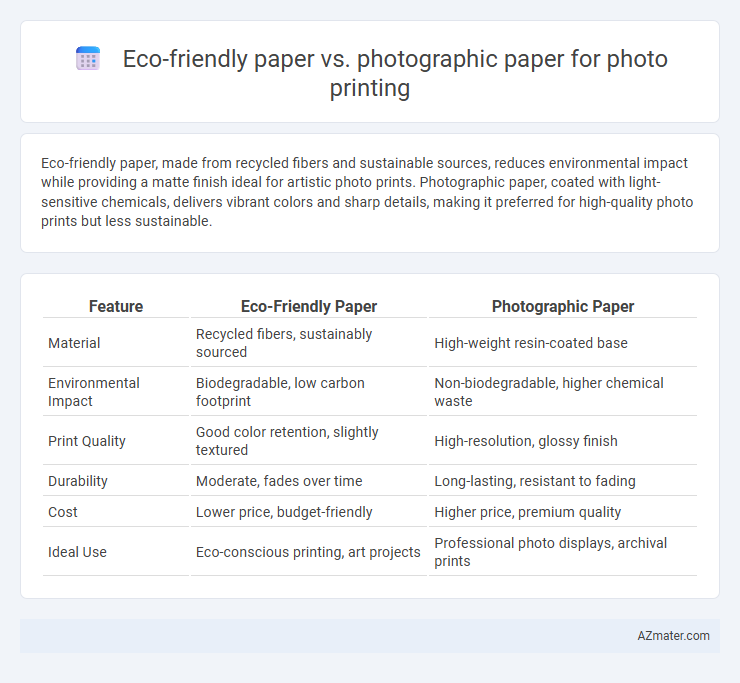Eco-friendly paper, made from recycled fibers and sustainable sources, reduces environmental impact while providing a matte finish ideal for artistic photo prints. Photographic paper, coated with light-sensitive chemicals, delivers vibrant colors and sharp details, making it preferred for high-quality photo prints but less sustainable.
Table of Comparison
| Feature | Eco-Friendly Paper | Photographic Paper |
|---|---|---|
| Material | Recycled fibers, sustainably sourced | High-weight resin-coated base |
| Environmental Impact | Biodegradable, low carbon footprint | Non-biodegradable, higher chemical waste |
| Print Quality | Good color retention, slightly textured | High-resolution, glossy finish |
| Durability | Moderate, fades over time | Long-lasting, resistant to fading |
| Cost | Lower price, budget-friendly | Higher price, premium quality |
| Ideal Use | Eco-conscious printing, art projects | Professional photo displays, archival prints |
Introduction to Eco-Friendly and Photographic Paper
Eco-friendly paper is made from sustainable resources such as recycled fibers or responsibly harvested wood, minimizing environmental impact through reduced chemical usage and energy consumption. Photographic paper is specifically engineered for high-quality photo prints, featuring a coated surface that enhances color vibrancy, sharpness, and longevity. Choosing between eco-friendly and photographic paper involves balancing environmental responsibility with the desired print clarity and color accuracy.
Environmental Impact: Comparing Paper Types
Eco-friendly paper for photo prints significantly reduces environmental impact by using recycled materials and sustainable fibers, lowering carbon footprint and deforestation rates. Photographic paper, typically coated with chemicals and polyester layers, poses challenges for biodegradability and recycling, contributing to landfill waste and potential soil contamination. Choosing eco-friendly paper supports conservation efforts and promotes a circular economy in the printing industry.
Materials and Manufacturing Processes
Eco-friendly paper for photo prints is typically made from recycled fibers or sustainably sourced materials, minimizing environmental impact through reduced deforestation and lower energy consumption during production. Photographic paper, on the other hand, consists of a traditional base coated with light-sensitive chemicals like silver halide crystals, requiring intensive manufacturing steps such as emulsion coating and chemical processing. Sustainable manufacturing of eco-friendly paper often involves non-toxic bleaching agents and water-efficient techniques, while photographic paper production relies heavily on chemical baths and energy-intensive drying processes.
Print Quality and Color Accuracy
Eco-friendly paper offers moderate print quality and color accuracy, often producing softer tones ideal for environmentally conscious prints but may lack the sharpness and vibrancy seen in photographic paper. Photographic paper delivers superior print quality with high resolution and exceptional color accuracy, capturing fine details and vivid hues essential for professional photo prints. While eco-friendly paper prioritizes sustainability, photographic paper excels in preserving image fidelity and intensity.
Durability and Longevity of Photo Prints
Eco-friendly paper for photo prints offers moderate durability with resistance to fading due to its recycled fibers and eco-conscious coatings, making it suitable for short- to medium-term display. Photographic paper, especially those with silver halide or resin-coated layers, provides superior longevity and color stability, often lasting decades without significant degradation under proper archival conditions. Choosing photographic paper ensures maximum preservation of image quality, while eco-friendly alternatives balance environmental impact with acceptable durability for everyday use.
Cost Considerations for Eco-Friendly and Photographic Paper
Eco-friendly paper typically offers lower production costs due to the use of recycled materials and reduced chemical processes, making it a budget-friendly option for photo printing. Photographic paper involves higher expenses because of specialized coatings and advanced photo-sensitive layers required for superior image quality and color accuracy. Choosing between these papers depends on balancing cost efficiency against print longevity and visual fidelity requirements.
Compatibility with Photo Printers
Eco-friendly paper offers compatibility with most inkjet and laser photo printers, providing a sustainable choice without compromising print quality. Photographic paper, specifically designed for photo printers, ensures optimal color accuracy and sharpness through specialized coatings that absorb ink efficiently. Printer manufacturers often recommend using photographic paper to achieve superior results, though eco-friendly options are increasingly engineered to meet high-performance standards.
Aesthetic Differences in Photo Finish
Eco-friendly paper offers a matte or textured finish that enhances warmth and organic charm in photo prints, emphasizing natural tones and subtle grain for a handcrafted aesthetic. Photographic paper delivers a high-gloss or semi-gloss surface, resulting in sharp, vibrant colors with deep contrast and a polished, professional appearance. The choice between eco-friendly and photographic paper significantly affects the visual impact, with eco-friendly paper favoring a soft, earthy feel and photographic paper providing vivid clarity and brilliance.
Consumer Preferences and Market Trends
Eco-friendly paper is gaining traction among environmentally conscious consumers prioritizing sustainability and reduced carbon footprint over traditional photographic paper. Market trends indicate a rising demand for recycled and biodegradable photo print materials, driven by increased awareness of environmental impact and regulatory incentives. Consumer preferences now often favor eco-friendly paper for its ethical appeal and compatibility with digital printing technologies, despite photographic paper's superior image quality and color vibrancy.
Choosing the Best Paper for Sustainable Photo Printing
Eco-friendly paper offers a sustainable alternative to traditional photographic paper by using recycled fibers and non-toxic inks, significantly reducing environmental impact. Photographic paper typically provides higher color accuracy and durability but often involves chemicals and plastic coatings that hinder recyclability and biodegradability. Selecting eco-friendly paper for photo printing supports sustainability goals by balancing image quality and ecological responsibility, making it the preferred choice for environmentally conscious photographers.

Infographic: Eco-friendly paper vs Photographic paper for Photo print
 azmater.com
azmater.com